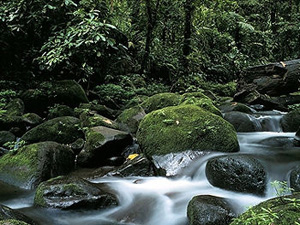|
Web Extra Friday, June 1, 2007
Amazon emits a lot of methane
 NASA Earth Observatory |
| New research suggests that the Amazon Basin, pictured here, emits significantly more methane than previously thought. |
For a long time, people have recognized that the Amazon Basin
is a significant source of methane, says John Miller, a research scientist at
the NOAA Earth System Research Laboratory in Boulder, Colo.
New research, however, is showing that the Amazon Basin is actually emitting
substantially higher volumes of methane than previously estimated. Considering
methane is 21 times stronger as a greenhouse gas than carbon dioxide, researchers
say, getting a handle on just how much methane is being emitted into the atmosphere
is important.
From 2000 to 2003, Miller and his colleagues measured methane content over two
sites in the central Amazon Basin at various altitudes during both the wet and
dry seasons. From the surface to about four kilometers (about 2.5 miles) high,
the team found between 34 and 200 parts per billion more methane than other
measurements had shown over the basin, they reported May 25 in Geophysical
Research Letters. "The fluxes that we estimate are substantially larger
than what others have shown," Miller says: "The Amazon is even more
important than we previously thought."
Miller's team also investigated the source of the methane. Much of the Amazon
Basin is wetlands, which are the single most significant source of atmospheric
methane globally. But the Amazon is also filled with trees and plants, which
recent research has suggested also emit a lot of methane (see Geotimes
online, Web Extra, Jan. 13, 2006). Miller says that neither plant emissions
nor wetland emissions by themselves can explain the high methane emissions the
team observed, but, he says, "if I had to guess, I'd say wetlands come
closer" to explaining the volumes.
Differentiating various sources of methane emissions is difficult, but can be
done, he says, as isotopic ratios can separate emissions from wetlands, coal
mines, biomass burning, animals and fossil fuel use. But separating wetlands
from plant emissions is "extraordinarily difficult" he says, as any
difference in the isotopic ratio would be "very, very small." Then
there is the question of whether or not plants actually emit methane: A new
study published April 27 in New Phytologist online suggests that there
is no evidence that plants emit a substantial amount of methane. "More
laboratory and field studies would definitely help," Miller says.
"I don't think anyone would claim to have the whole atmospheric methane
picture solved," Miller says. "With each new study or sampling project,
we learn more and more about what's really going on" in the atmospheric
methane budget, he says.
Links:
"Methane
budget to become off-balance," Geotimes, December 2006
"Methane
climate menagerie," Geotimes, December 2006
"Plant methane
surprises climate scientists," Geotimes online, Web Extra, Jan.
13, 2006
NOAA
Earth System Research Laboratory Global Monitoring Division

 Subscribe
Subscribe


